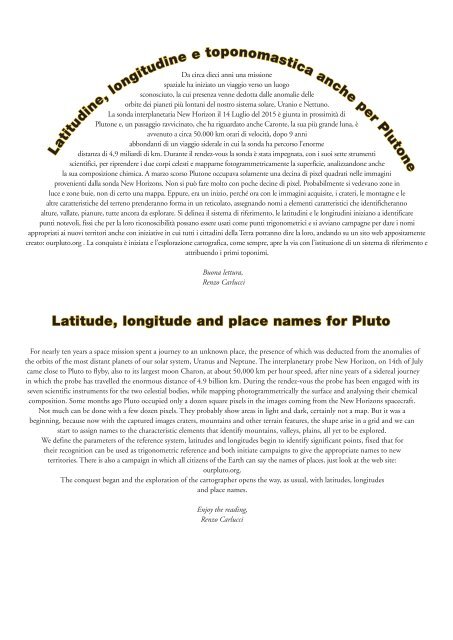GEOmedia 3-2015
Speciale INTERGEO 2015
Speciale INTERGEO 2015
Create successful ePaper yourself
Turn your PDF publications into a flip-book with our unique Google optimized e-Paper software.
Da circa dieci anni una missione<br />
spaziale ha iniziato un viaggio verso un luogo<br />
sconosciuto, la cui presenza venne dedotta dalle anomalie delle<br />
orbite dei pianeti più lontani del nostro sistema solare, Uranio e Nettuno.<br />
La sonda interplanetaria New Horizon il 14 Luglio del <strong>2015</strong> è giunta in prossimità di<br />
Plutone e, un passaggio ravvicinato, che ha riguardato anche Caronte, la sua più grande luna, è<br />
avvenuto a circa 50.000 km orari di velocità, dopo 9 anni<br />
abbondanti di un viaggio siderale in cui la sonda ha percorso l’enorme<br />
distanza di 4,9 miliardi di km. Durante il rendez-vous la sonda è stata impegnata, con i suoi sette strumenti<br />
scientifici, per riprendere i due corpi celesti e mapparne fotogrammetricamente la superficie, analizzandone anche<br />
la sua composizione chimica. A marzo scorso Plutone occupava solamente una decina di pixel quadrati nelle immagini<br />
provenienti dalla sonda New Horizons. Non si può fare molto con poche decine di pixel. Probabilmente si vedevano zone in<br />
luce e zone buie, non di certo una mappa. Eppure, era un inizio, perché ora con le immagini acquisite, i crateri, le montagne e le<br />
altre caratteristiche del terreno prenderanno forma in un reticolato, assegnando nomi a elementi caratteristici che identificheranno<br />
alture, vallate, pianure, tutte ancora da esplorare. Si delinea il sistema di riferimento, le latitudini e le longitudini iniziano a identificare<br />
punti notevoli, fissi che per la loro riconoscibilità possano essere usati come punti trigonometrici e si avviano campagne per dare i nomi<br />
appropriati ai nuovi territori anche con iniziative in cui tutti i cittadini della Terra potranno dire la loro, andando su un sito web appositamente<br />
creato: ourpluto.org . La conquista è iniziata e l’esplorazione cartografica, come sempre, apre la via con l’istituzione di un sistema di riferimento e<br />
attribuendo i primi toponimi.<br />
Latitudine, longitudine e toponomastica anche per Plutone<br />
Buona lettura,<br />
Renzo Carlucci<br />
Latitude, longitude and place names for Pluto<br />
For nearly ten years a space mission spent a journey to an unknown place, the presence of which was deducted from the anomalies of<br />
the orbits of the most distant planets of our solar system, Uranus and Neptune. The interplanetary probe New Horizon, on 14th of July<br />
came close to Pluto to flyby, also to its largest moon Charon, at about 50,000 km per hour speed, after nine years of a sidereal journey<br />
in which the probe has travelled the enormous distance of 4.9 billion km. During the rendez-vous the probe has been engaged with its<br />
seven scientific instruments for the two celestial bodies, while mapping photogrammetrically the surface and analysing their chemical<br />
composition. Some months ago Pluto occupied only a dozen square pixels in the images coming from the New Horizons spacecraft.<br />
Not much can be done with a few dozen pixels. They probably show areas in light and dark, certainly not a map. But it was a<br />
beginning, because now with the captured images craters, mountains and other terrain features, the shape arise in a grid and we can<br />
start to assign names to the characteristic elements that identify mountains, valleys, plains, all yet to be explored.<br />
We define the parameters of the reference system, latitudes and longitudes begin to identify significant points, fixed that for<br />
their recognition can be used as trigonometric reference and both initiate campaigns to give the appropriate names to new<br />
territories. There is also a campaign in which all citizens of the Earth can say the names of places, just look at the web site:<br />
ourpluto.org.<br />
The conquest began and the exploration of the cartographer opens the way, as usual, with latitudes, longitudes<br />
and place names.<br />
Enjoy the reading,<br />
Renzo Carlucci


















